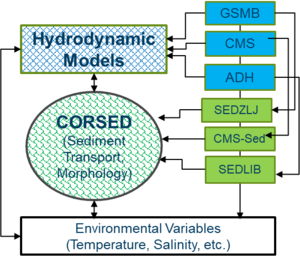CORSED
Background
ERDC maintains multiple sediment transport codes developed by different teams for differing purposes. Each code has advantages and limitations. The SEDZLJ code was originally developed at the University of California at Santa Barbara for the Environmental Protection Agency (EPA) in order to simulate transport of predominately fine-grained (silt/clay) cohesive sediment in current-dominated environments. SEDZLJ has been modified by ERDC for mixed sediment transport (sand/silt/clay) in coastal environments. Sand transport applications in SEDZLJ are typically limited to two sediment classes. Another ERDC developed sediment transport code is SEDLIB which was developed to simulate multi-grain transport in rivers and creeks. SEDLIB was specifically designed to simulate transport and winnowing of multiple sand classes. SEDLIB also includes cohesive silt/clay transport algorithms, although these have not been exercised sufficiently in real-world applications. Many routines in SEDLIB are based on the TABS code routines, which is still widely applied at ERDC for reimbursable projects.
The SEDZLJ and SEDLIB transport programs have received ERDC research funds over the past five years. Most of the recent SEDLIB funding is through the ERDC 219 program. SEDZLJ development was funded at a much lower level through the DOER program prior to FY16. SEDZLJ is the ERDC workhorse code for cohesive sediment transport in stratified coastal systems. SEDLIB has mostly been applied for reimbursable projects as a sand transport code in riverine systems. Coastal and estuarine capabilities remain inadequately tested. In addition, TABS is still used for reimbursable projects, although no research funds have been used to improve the model in over ten years.
Versions of SEDZLJ exist which include transport of contaminants which adhere to fine-grained sediment. This code has been applied for multiple reimbursable projects, predominately funded by EPA. FY18 ERDC-219 funding includes a project to incorporate contaminant transport into SEDLIB.
SEDZLJ reimbursable projects are performed in the EFDC and CH3D hydrodynamic models. SEDLIB operates primarily within the ADH hydrodynamic model. Both SEDZLJ and SEDLIB exist as libraries, which permits them to be used by alternative hydrodynamic models. However, at present, only SEDZLJ has been exported to and alternative hydrodynamic framework (ADH) and (CMS), but testing is still required.
ERDC has invested significant manpower and funding to developing two alternative sediment transport frameworks. What is required is one sediment transport code which operates across multiple hydrodynamic platforms and permits user-selected features from both SEDZLJ and SEDLIB. This unitary library code will permit ERDC to compete efficiently with other models (DELFT3D, MIKE, TELEMAC) and provide the best transport predictions to clients in a cost effective manner.
Need

ERDC maintains multiple sediment transport codes developed by different teams for differing purposes. Each code has advantages and limitations. The SEDZLJ code was originally developed to simulate transport of predominately fine-grained (silt/clay) cohesive sediment in current-dominated environments. SEDZLJ has been modified by ERDC for mixed sediment transport (sand/silt/clay) in coastal environments. SEDZLJ is the ERDC workhorse code for cohesive sediment transport in stratified coastal systems. Another ERDC developed sediment transport code is SEDLIB which was developed to simulate multi-grain transport in rivers and creeks. SEDLIB was specifically designed to simulate transport and mixing of multiple sand classes. SEDLIB has mostly been applied for reimbursable projects as a sand transport code in riverine systems. Coastal and estuarine capabilities are currently being readied for field use. ERDC has invested significant manpower and funding to developing two alternative sediment transport codes. What is required is one consolidated sediment transport code (CORSED) which operates across multiple hydrodynamic platforms and permits user-selected features from both SEDZLJ and SEDLIB. This unitary library code will permit ERDC to compete efficiently with other models and provide the best transport predictions to clients in a cost effective manner.